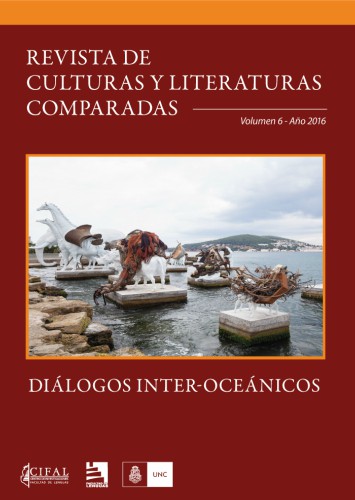The Return of the Barbarians: Semiotic Borders and the Demystification of Cultural Complexes in the Figure of the Viking
Keywords:
barbarism, modelization, cultural boundariesAbstract
Through a genealogy of "the barbarian", certain textualities make visible a topology that shows the boundaries of what is expressible or not about the alleged existence of a particular type of pre-men living in an (un)cultural and wild world: figures of the barbaric that reflect an attempt at ordering, a struggle against entropy and chaos and a mechanism of rationalization of a cultural-Other, resulting in intercultural problems still existing in some contemporary texts. In this paper, we are interested in addressing their contemporary representations, through one of its most recurrent modelization: the Viking. But, why does a
cultural text as the Viking remain even centuries later? What subjectivities are woven from certain recurrences, repetitions and refractions that revitalize an atavism and barbarity in apparently civilized humans? Which semiotics fracture inscribes a difference on the treatment of the “wild” other that becomes visible in some current enunciations? In the field of cultural semiotics, we understand that it is possible to shed light on these questions based on how, through certain semiotic operations, meanings are transformed and selected, defining otherness and formulating a map of senses around a Viking construction. Thus, in its various present representations, we can visualize a trope produced by an amalgam of senses and imaginaries that manifest figures located outside civilization: that is, a polyaccented and mythical construction that interweaves with the great problems of Western culture and embodies an imaginary capable of reworking and translating new readings that reterritorialize the opposition identity/otherness through a process of textual integration.
Downloads
References
Balandier, Georges. El Desorden. La Teoría del Caos y las Ciencias Sociales. Barcelona: Gedisa, 1988.
Balar, Keya. “Historical Inaccuracies in 'Vikings'” en The Daily Targum. 2015. Edición digital, revisado el 11 de agosto de 2015.
Barei, Silvia y Arán, Pampa. Texto / memoria / cultura. El pensamiento de Iuri Lotman. Córdoba: El Espejo Editores, 2002.
Barei, Silvia y Molina Ahumada, Pablo. Perspectivas Retóricas. Córdoba: Ferreyra Editor, 2008.
Barei, Silvia. Culturas en conflicto. Córdoba: Ferreyra Editor, 2012.
Barthes, Roland. El sistema de la moda y otros ensayos. Barcelona: Paidós, 2003.
Bartra, Roger. “El mito del salvaje” en Ciencias. Vol. 60-61. Pp. 88-96. 2001. Edición digital.
Benjamin, Walter. Discursos interrumpidos I. Madrid: Taurus, 1979.
Borges, Jorge Luis. Literaturas germánicas medievales. Madrid: Alianza Editorial, 1980
–----------------------. Obras completas. Buenos Aires: Sudamericana, 2009.
Clements, Jonathan. Los vikingos. Los últimos paganos. Buenos Aires: Editorial Vergara, 2008.
Corson, Richard. Fashions in Hair: The First Five Thousand Years. Londres: Peter Owen Publishing, 2001.
De Cobarrubias, Sebastián (1989[1661]). Tesoro de la lengua castellana o española.
Barcelona: Alta Fulla, 1989[1661]. Edición digital.
Eco, Umberto. La historia de la belleza. Barcelona: Lumen, 2004.
–----------------------. La historia de la fealdad . Barcelona: Lumen, 2007.
Gómez Ponce, Ariel. “Poliglotismo serial. Aspectos metodológicos en el estudio semiótico-cultural de las series televisivas contemporáneas” (2014) en Actas IV Jornadas Internacionales: Tecnologías aplicadas a la enseñanza de lenguas . Córdoba: Editorial Facultad de Lenguas. En prensa.
Hadis, Martín y Arias, Martín. Borges, profesor. Curso de Literatura Inglesa en la Universidad de Buenos Aires. Buenos Aires: Emecé, 2002.
Holman, Katherine. The Northern Conquest. Vikings in Britain and Ireland. Oxford: Signal Books Limited, 2012.
Ibn Battúta. Travels in Asia and Africa. Londres: Routledge and Kegan Paul, 1929. Edición digital.
Kristeva, Julia. Strangers to Ourselves. New York: Columbia University Press, 1991. Lindow, John. Norse Mythology: A Guide to the Gods, Heroes, Rituals and Beliefs . Londres: Oxford University Press, 2001.
López-Ríos, Santiago. “El hombre salvaje entre el Renacimiento y la Edad Media: leyenda oral, iconográfica y literaria” en Cuadernos del CEMyR. Vol. 14. Pp. 233-249. 2006. Edición digital.
Lotman, Iuri. Estética y semiótica del cine. Madrid: Gusavo Gili Editores, 1979.
–------------------. La Semiosfera I. Madrid: Frónesis Cátedra, 1996.
–------------------. Cultura y explosión. Lo previsible y lo imprevisible en los procesos de cambio social . Bacerlona: Gedisa, 1999.
–------------------. La Semiosfera III. Madrid: Frónesis Cátedra, 2000.
–------------------. “La caza de brujas: semiótica del miedo” en Navarro, Desiderio [comp.] El pensamiento cultural ruso en Criterios. 1972-2008. Tomo I. La Habana: Centro Teórico-Cultural Criterios, 2009.
Lorenz, Konrad. Sobre la agresión: el pretendido mal. México: Siglo XXI, 2005[1971]. Maffesoli, Michel. Ensayos sobre la violencia banal y fundadora. Buenos Aires: Dedadus Editores, 2009.
McCullough, David. Wars of the Irish Kings: A Thousand Years of Struggle, from the Age of Myth through the Reign of Queen Elizabeth I. New York: Three Rivers Press, 2010.
McTurk, Rory. “Kings and Kingship in Viking Northumbria” en McKinell, John[ed.]. The Fantastic in Old Norse Icelandic Literature, Vol. 1. 681-688. Londres: Centre for Medieval and Renaissance Studies Publishing, 2006.
Morin, Edgar. Breve Historia de la Barbarie en Occidente. Barcelona: Paidós, 2009.
Ragnars Saga Loðbrokar . Traducción al inglés por Chris Van Dyke. Denver: Cascadian Publishing, 2003. Edición digital.
Richards, Julian. The Vikings. A very short introduction. New York: Oxford University Press, 2005.
Todd, James Henthron [ed.]. The Invasions of Ireland by the Danes and Other Norsemen. Londres: Longman, 1897. Edición digital.
Tinbergen, Niko. El estudio del instinto. México: Siglo XXI, 1969.
Downloads
Published
Issue
Section
License
Aquellos/as autores/as que tengan publicaciones con esta revista, aceptan los términos siguientes:
a) Los/as autores/as conservarán sus derechos de autor y garantizarán a la revista el derecho de primera publicación de su obra, el cual estará simultáneamente sujeto a la Licencia de reconocimiento de Creative Commons.
b) La cesión de derechos no exclusivos implica que la publicación de los artículos en la presente revista no quita la posibilidad o el derecho al autor/a de publicar su obra de manera posterior en otras revistas u órganos editoriales y la autorización por parte de los/as autores/as para que el trabajo sea depositado en los repositorios institucionales, tales como el Portal de Revistas de la Universidad Nacional de Córdoba.



